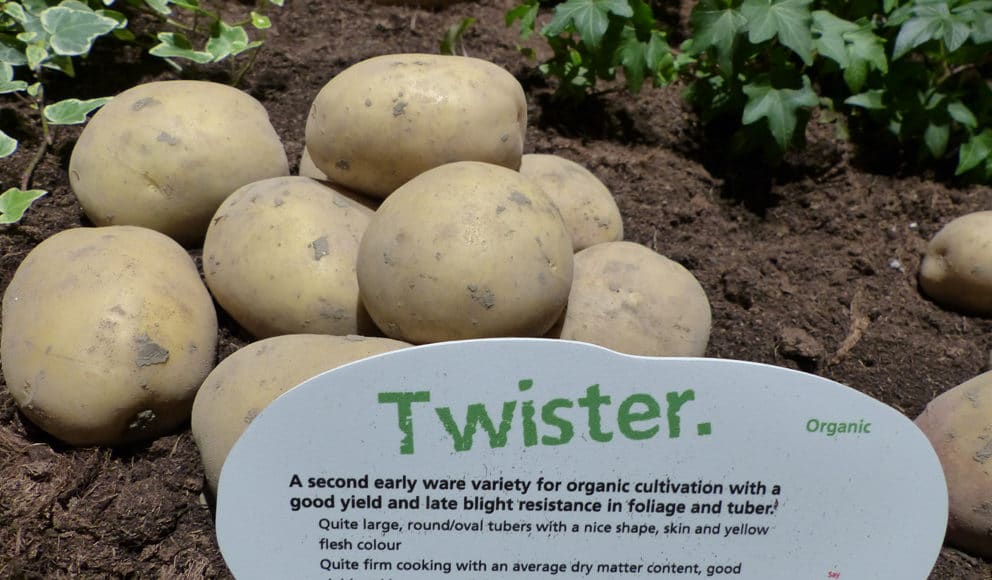Potato Days is held the second week of November every year in The Netherlands. At this event, Dutch potato breeding companies showcase their varieties and clones for the table and processing markets.
The three-day event attracts hundreds of potato growers and industry personnel from all over the world. Most companies have their offices near the city of Emmeloord, which makes visiting the different breeding companies easy.
HZPC, a world leader in potato breeding, seed potato trade and product concept development, had an impressive display of approximately 150 varieties and clones arranged in three circular display floors. Each floor had a theme: the second floor was for the North American market, the most interesting for Canadian attendees.
This past season, I evaluated HZPC varieties and clones in an irrigated commercial field near Alliston, Ont. Many of these varieties – Noblesse, Primabelle and Panamera to name a few – were showcased in the North American section. There were no important differences between the potatoes produced in the Alliston trial and the HZPC display.
Jack Streef, a potato grower from Streef Produce in Princeton, Ont., was also attending the Dutch Potato Days. Jack and I agreed the HZPC new potato variety Briosa looked promising for the Ontario fresh market. Briosa is a medium early, yellow-fleshed variety with attractive oval tubers. It sets 9-11 tubers per hill. The eyes are pinkish, very similar to Yukon Gold. The dormancy period is medium.
Briosa has some tolerance to scab and is highly resistant to early blight. No potato variety is perfect; Briosa is susceptible to the “little potato disorder” caused by hot weather. I will be able to evaluate Briosa in 2017 because it is at the minituber stage in the Canadian certification system.
Besides the impressive display of potato varieties, the HZPC open house also featured the company Solentum, which has developed the Solgrader smartphone app to estimate yield and tuber size distribution based on photos taken with a smartphone. The Solgrader app works like this:

Photo: Solentum
- Using their smartphone, growers enter basic information such as variety, acreage, planting distance and row width.
- A hill of potatoes is dug, tubers are placed on a special blue mat.
- Using the smartphone Solgrader app, growers take a photo of the tubers.
- The app immediately calculates tuber size distribution, tuber weight and estimated yield per acre.
The process can be repeated on a few other locations for even better reliability.
Agrico is another large Dutch potato breeding company. Parkland Seed Potatoes based in Alberta is their representative in Canada. The display of Agrico was innovative and attractive. Two varieties, Twister and Constance looked promising for the Ontario market.
Agrico recommends Twister for organic growers because it is resistant to common scab, viruses and late blight. It has low susceptibility to bruising. The tubers are oval and yellow-fleshed. Maturity is medium early.
Constance caught my attention because it is heat tolerant. Tubers are round-oval and the flesh is light yellow.
Two other varieties showcased by Agrico were Arizona (light yellow flesh) and Volare (white flesh). I have evaluated them in Ontario and although they have favourable traits, both are highly susceptible to common scab.
Den Hartigh is the Dutch affiliate of Solana, a German potato breeding company. They showcased 50 varieties for the table and processing markets.
Den Hartigh had innovative displays to demonstrate the influence of soil type on the tuber skin finish and/or any tuber problem that may develop during the growing season. All the varieties were grown at three locations: in a sandy soil infested with scab; and in two heavier soils, one with 18 per cent clay, the other with 50 per cent clay. This showed which varieties were tolerant to scab. It also showed how soil type affects yield and skin finish of tubers.
The variety Laperla looked promising. It is early, has light yellow flesh and smooth skin. It is reported to be drought tolerant and resistant to silver scurf, which is why I would like to include Laperla in a variety trial in Ontario. Laperla is marketed in Canada by the company Solanum International, which is based in Alberta.
Stet Holland is a subsidiary of HZPC. This past season, I evaluated three varieties that were showcased as the most promising: Salinero, Tyson and Zina Red. In my trials, they also looked promising.
The breeding companies Meijer, van Rijn, Norika and De Nijs had very interesting varieties in their displays.
All the breeding companies I visited showcased processing varieties for the chipping and the French fry markets. I have evaluated a few of the chipping varieties showcased at the Potato Days, but the fry colour was not acceptable by Ontario standards.
The 2016 Potato Days in The Netherlands was a great event. Not only was it a chance to see the newest varieties and promising clones, but it was also a chance to see the latest technological developments.











